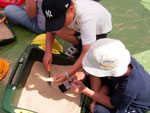Have you had time to get outdoors this summer? Toured any historical sites? As you walked across a battlefield, by a historical house, or through the remains of an abandoned pueblo or factory, have you thought about how we know what we know about these places? Primary sources describing some sites exist, but we can also learn about historical places through exploration and observation, treating the site itself as a primary source. Archaeologists analyze a place with sharp eyes, specialized tools, and historical knowledge, keeping close records of what they discover.
Remember that archaeology doesn't have to mean ancient history!
The National Park Service (NPS) encourages teaching students about archaeology. According to the NPS, archaeological knowledge can help students better understand the need for stewardship of historical and cultural resources. An NPS roundup of guides, lesson plans, online activities, and more can help you start training students as "public history citizens." Students can introduce themselves to the basic concepts of archaeology with the exhibit "Archeology for Kids," while "Visit Archeology" guides visitors to NPS sites where archaeologists have worked.
Remember that archaeology doesn't have to mean ancient history! For instance, students in Massachusetts have learned about local history by helping dig up the remnants of an 18th-century bottle factory (read more). Archaeologists have worked in the ruins of plantations, slave quarters, and homesteads to learn more about the lives of African Americans both free and enslaved (see NPS's guide to archaeology and African American history or click on "Scholars" at the Smithsonian Anacostia Community Museum's Online Academy for videos about African American artifacts).
Archaeologists work everywhere. They may dig on the bottom of the ocean (or lakes or rivers) to uncover shipwrecks. They sift with care through early Native American sites to form theories about the lives of cultures like the Mississippi River moundbuilders (take a quiz to test your knowledge of early cultures).
Project Archaeology offers online and in-the-field archaeology professional development.
Interested in getting your students out in the field (or in bringing techniques from the field to them)? A number of programs exist. In addition to the NPS, the Bureau of Land Management's "Learning Landscapes" program promotes the educational use of public lands. They offer classroom activities on New Mexico's Tewa villages, artifacts from early North Americans in Alaska, cultural contact at a Spanish fort, and railroads. Students and teachers can also explore "History Mysteries" related to public sites.
The Bureau of Land Management also offers online and in-the-field archaeology professional development through Project Archaeology, a national education program. Through hands-on (or virtual) experience, participants learn how to use archaeology and "archaeological thinking" to grow student understanding of history, science, math, art, language arts, and other subjects. Teachers come away with curriculum guides designed for third through eighth grade. Check out Project Archaeology's "Teachers" page for photos from past workshops and the calendar for upcoming professional development. You can also contact your state or regional Project Archaeology coordinator about professional development opportunities in your area.
Even if you and your students never have the chance to get your hands dirty, archaeological skills can sharpen historical thinking. Archaeology requires close observation, precision, patience, respect for the past, knowledge from many subjects, and an inquisitive mind. Asking your students to "think like archaeologists" can help bring math, science, and hands-on enthusiasm to your history classroom.
